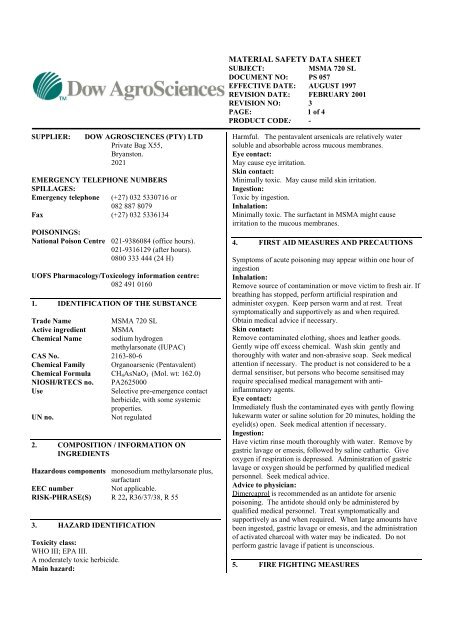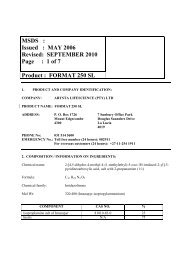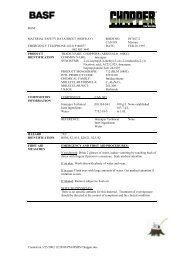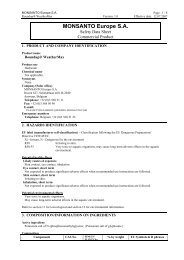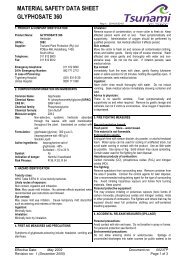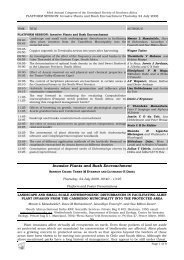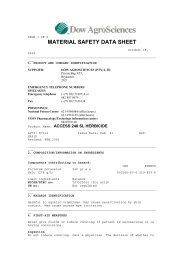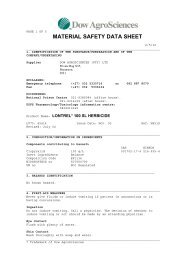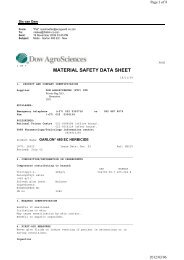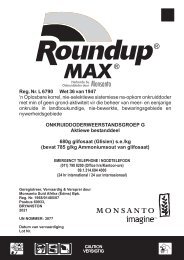MSDS - MSMA 720 SL.pdf - Bush Encroachment
MSDS - MSMA 720 SL.pdf - Bush Encroachment
MSDS - MSMA 720 SL.pdf - Bush Encroachment
Create successful ePaper yourself
Turn your PDF publications into a flip-book with our unique Google optimized e-Paper software.
MATERIAL SAFETY DATA SHEET<br />
SUBJECT:<br />
<strong>MSMA</strong> <strong>720</strong> <strong>SL</strong><br />
DOCUMENT NO: PS 057<br />
EFFECTIVE DATE: AUGUST 1997<br />
REVISION DATE: FEBRUARY 2001<br />
REVISION NO: 3<br />
PAGE: 1 of 4<br />
PRODUCT CODE: -<br />
SUPPLIER:<br />
DOW AGROSCIENCES (PTY) LTD<br />
Private Bag X55,<br />
Bryanston.<br />
2021<br />
EMERGENCY TELEPHONE NUMBERS<br />
SPILLAGES:<br />
Emergency telephone (+27) 032 5330716 or<br />
082 887 8079<br />
Fax (+27) 032 5336134<br />
POISONINGS:<br />
National Poison Centre 021-9386084 (office hours).<br />
021-9316129 (after hours).<br />
0800 333 444 (24 H)<br />
UOFS Pharmacology/Toxicology information centre:<br />
082 491 0160<br />
1. IDENTIFICATION OF THE SUBSTANCE<br />
Trade Name<br />
<strong>MSMA</strong> <strong>720</strong> <strong>SL</strong><br />
Active ingredient <strong>MSMA</strong><br />
Chemical Name sodium hydrogen<br />
methylarsonate (IUPAC)<br />
CAS No. 2163-80-6<br />
Chemical Family Organoarsenic (Pentavalent)<br />
Chemical Formula CH 4 AsNaO 3 (Mol. wt: 162.0)<br />
NIOSH/RTECS no. PA2625000<br />
Use<br />
Selective pre-emergence contact<br />
herbicide, with some systemic<br />
properties.<br />
UN no.<br />
Not regulated<br />
2. COMPOSITION / INFORMATION ON<br />
INGREDIENTS<br />
Hazardous components monosodium methylarsonate plus,<br />
surfactant<br />
EEC number<br />
Not applicable.<br />
RISK-PHRASE(S) R 22, R36/37/38, R 55<br />
3. HAZARD IDENTIFICATION<br />
Toxicity class:<br />
WHO III; EPA III.<br />
A moderately toxic herbicide.<br />
Main hazard:<br />
Harmful. The pentavalent arsenicals are relatively water<br />
soluble and absorbable across mucous membranes.<br />
Eye contact:<br />
May cause eye irritation.<br />
Skin contact:<br />
Minimally toxic. May cause mild skin irritation.<br />
Ingestion:<br />
Toxic by ingestion.<br />
Inhalation:<br />
Minimally toxic. The surfactant in <strong>MSMA</strong> might cause<br />
irritation to the mucous membranes.<br />
4. FIRST AID MEASURES AND PRECAUTIONS<br />
Symptoms of acute poisoning may appear within one hour of<br />
ingestion<br />
Inhalation:<br />
Remove source of contamination or move victim to fresh air. If<br />
breathing has stopped, perform artificial respiration and<br />
administer oxygen. Keep person warm and at rest. Treat<br />
symptomatically and supportively as and when required.<br />
Obtain medical advice if necessary.<br />
Skin contact:<br />
Remove contaminated clothing, shoes and leather goods.<br />
Gently wipe off excess chemical. Wash skin gently and<br />
thoroughly with water and non-abrasive soap. Seek medical<br />
attention if necessary. The product is not considered to be a<br />
dermal sensitiser, but persons who become sensitised may<br />
require specialised medical management with antiinflammatory<br />
agents.<br />
Eye contact:<br />
Immediately flush the contaminated eyes with gently flowing<br />
lukewarm water or saline solution for 20 minutes, holding the<br />
eyelid(s) open. Seek medical attention if necessary.<br />
Ingestion:<br />
Have victim rinse mouth thoroughly with water. Remove by<br />
gastric lavage or emesis, followed by saline cathartic. Give<br />
oxygen if respiration is depressed. Administration of gastric<br />
lavage or oxygen should be performed by qualified medical<br />
personnel. Seek medical advice.<br />
Advice to physician:<br />
Dimercaprol is recommended as an antidote for arsenic<br />
poisoning. The antidote should only be administered by<br />
qualified medical personnel. Treat symptomatically and<br />
supportively as and when required. When large amounts have<br />
been ingested, gastric lavage or emesis, and the administration<br />
of activated charcoal with water may be indicated. Do not<br />
perform gastric lavage if patient is unconscious.<br />
5. FIRE FIGHTING MEASURES
MATERIAL SAFETY DATA SHEET<br />
SUBJECT:<br />
<strong>MSMA</strong> <strong>720</strong> <strong>SL</strong><br />
DOCUMENT NO: PS 057<br />
EFFECTIVE DATE: AUGUST 1997<br />
REVISION DATE: FEBRUARY 2001<br />
REVISION NO: 3<br />
PAGE: 2 of 4<br />
PRODUCT CODE: -<br />
Extinguishing agents:<br />
Small fires: Extinguish with carbon dioxide, dry powder,<br />
halon or alcohol-resistant foam.<br />
Large fires: Carbon dioxide, dry powder, halon or alcoholresistant<br />
foam. Water spray or fog can be used for or cooling<br />
of unaffected stock, but avoid the accumulation of polluted<br />
run-off from the site.<br />
Remove container from fire area if possible. Contain fire<br />
control water for later disposal. Use a recommended<br />
extinguishing agent for the type of surrounding fire.<br />
Avoid inhaling hazardous vapours. Keep material away from<br />
water sources and sewers. Do not touch material and avoid<br />
breathing fumes. Keep upwind.<br />
Special hazards:<br />
Fire may produce irritating or poisonous vapours<br />
(arsenicoxides and oxides of sodium), mists or other products<br />
of combustion.<br />
Personal protective equipment:<br />
Fire-fighters and others that may be exposed should wear full<br />
protective clothing and self-contained breathing apparatus.<br />
6. ACCIDENTAL RELEASE MEASURES<br />
(SPILLAGE)<br />
Personal precautions:<br />
Avoid contact with skin and eyes. Do not inhale fumes. For<br />
personal protection see Section 8. In view of the toxicity<br />
induced in experimental animals on repeated exposure, proper<br />
care should be taken during occupational use to avoid<br />
ingestion of spray particles, and to prevent accidental<br />
contamination of food products and water.<br />
Environmental precautions:<br />
Do not allow to enter drains or water courses. When the<br />
product contaminates public waters, inform appropriate<br />
authorities in accordance with local regulations.<br />
Occupational spill: For small liquid spills, soak up with sand<br />
or other suitable noncombustible absorbent material, such as<br />
sawdust, and place into containers for subsequent disposal.<br />
For large spills, contain liquid far ahead of spill. Contain<br />
spillage and contaminated water for subsequent disposal. Do<br />
not flush spilled material into drains. Keep spectators away.<br />
7. HANDLING AND STORAGE REQUIREMENTS<br />
Handling:<br />
Harmful if swallowed. Avoid contact with eyes, prolonged<br />
contact with skin, and inhalation of fumes or spray mist. Use<br />
with adequate ventilation. Wash hands before eating, drinking,<br />
chewing gum, smoking, or using the toilet. Remove clothing<br />
immediately if the herbicide gets inside. Then wash skin<br />
thoroughly using a non-abrasive soap and put on clean<br />
clothing. Do not apply directly to areas where surface water is<br />
present, or to intertidal areas below the mean high water mark.<br />
Water used to clean equipment must be disposed of correctly to<br />
avoid contamination.<br />
Storage:<br />
Store in its original labeled container in a shaded, wellventilated<br />
area, away from heat, sparks and other sources of<br />
ignition. Not to be stored next to foodstuffs and water<br />
supplies. Keep out of reach of children and animals. Local<br />
regulations should be complied with.<br />
8. EXPOSURE CONTROL / PERSONAL<br />
PROTECTION<br />
Occupational exposure limits:<br />
TLV (as As): 0.2 ppm; mg/m 3 (ACGIH 1991-1992)<br />
Engineering control measures:<br />
It is essential to provide adequate ventilation. The measures<br />
appropriate for a particular work site depend on how this<br />
material is used and on the extent of exposure. Ensure that<br />
control systems are properly designed and maintained. Comply<br />
with occupational safety, environmental, fire, and other<br />
applicable regulations. If engineering controls and work<br />
practices are not effective in controlling exposure to this<br />
material, then wear suitable personal protective equipment<br />
including approved respiratory protection.<br />
Respirator:<br />
An approved respirator suitable for protection from spray mists<br />
of pesticides is adequate. Limitations of respirator use<br />
specified by the approving agency and the manufacturer must<br />
be observed.<br />
Clothing:<br />
Employee must wear appropriate protective (impervious)<br />
clothing and equipment to prevent repeated or prolonged skin<br />
contact with this substance.<br />
Gloves:<br />
Employee must wear appropriate synthetic protective gloves to<br />
prevent contact with this substance.<br />
Eye protection:<br />
The use of safety goggles is recommended.<br />
Emergency eye wash: Where there is any possibility that an<br />
employee’s eyes may be exposed to this substance, the<br />
employer should provide an eye wash fountain or appropriate<br />
alternative within the immediate work area for emergency use.
MATERIAL SAFETY DATA SHEET<br />
SUBJECT:<br />
<strong>MSMA</strong> <strong>720</strong> <strong>SL</strong><br />
DOCUMENT NO: PS 057<br />
EFFECTIVE DATE: AUGUST 1997<br />
REVISION DATE: FEBRUARY 2001<br />
REVISION NO: 3<br />
PAGE: 3 of 4<br />
PRODUCT CODE: -<br />
9. PHYSICAL AND CHEMICAL PROPERTIES<br />
Appearance:<br />
A light green to slightly yellow liquid.<br />
Odour:<br />
Slight sweetish odour.<br />
Free arsenic:<br />
0,1% max.<br />
Explosive properties:<br />
Non explosive.<br />
Flammability:<br />
Non flammable. The product contains water.<br />
Corrosive properties:<br />
Corrosive to mild steel, aluminum, copper and tin<br />
pH:<br />
5.25 - 6.5 (neat).<br />
Density:<br />
1.5 g/ml<br />
Storage stability:<br />
Stable for up to 2 years under normal warehouse storage<br />
conditions. The product is stable after 14 days at 54 o C<br />
(accelerated storage test), and after 3 months at both<br />
25 o C and -3 o C.<br />
Solubility in water:<br />
Readily soluble in water.<br />
Solubility in organic solvents: (data for active ingredient)<br />
The product is soluble in methanol, but is insoluble in most<br />
organic solvents.<br />
Flash point:<br />
Not applicable.<br />
10. STABILITY AND REACTIVITY<br />
Stability:<br />
The product is stable to hydrolysis, but is decomposed by<br />
strong oxidising and reducing agents.<br />
Incompatibility:<br />
Spray solutions containing this product should be mixed,<br />
stored or applied using, fiberglass or plastic-lined containers<br />
and equipment. The product is corrosive to mild steel. The<br />
product is compatible with many herbicides when used at<br />
normal rates. However, a compatibility test is required before<br />
using with other products. Do not physically mix concentrate<br />
directly with other herbicides or pesticide concentrates; always<br />
dilute first.<br />
Hazardous decomposition products:<br />
Toxic fumes of arsenic oxides and toxic oxides of sodium are<br />
released when the product decomposes on heating.<br />
____________________________________________<br />
11. TOXICOLOGICAL INFORMATION<br />
Acute oral LD 50 :<br />
1 824 mg/kg in male rats.<br />
Acute dermal LD 50 :<br />
> 2 856 mg/kg in male rats.<br />
Acute inhalation LC 50 (4 h):<br />
> 5.260 mg/l of air.<br />
Acute skin irritation:<br />
The product may cause mild skin irritation (rabbits).<br />
Acute eye irritation:<br />
The product may cause mild eye irritation (rabbits).<br />
Dermal sensitisation:<br />
Not determined, due to the induced toxicity of the product.<br />
Carcinogenicity:<br />
Inadequate data available on organoarsenic products to<br />
determine product carcinogenicity<br />
Teratogenicity:<br />
Animal studies did not detect teratogenic effects.<br />
Mutagenicity:<br />
Animal studies did not detect mutagenic activity.<br />
12. ECOLOGICAL INFORMATION<br />
<strong>MSMA</strong> can be highly toxic to grazing stock and wildlife. It<br />
must only be used with the utmost caution and under<br />
supervision. The user is therefore warned that stock (or<br />
wildlife) must not be allowed to graze treated areas until at<br />
least one month has passed after treatment of jointed and other<br />
cacti and two months after treatment of prickly pear. Do not<br />
treat prickly pear during dry periods when no other source of<br />
fresh food is available (usually June to September -in South<br />
Africa).<br />
ECOTOXICOLOGY:<br />
Birds:<br />
(data for Mesanate 960TK)<br />
Low toxicity to birds.<br />
LD 50 : 425.2 g/kg (quail).<br />
LC 50 (5 day dietary):<br />
1 667 ppm (quail).<br />
> 2 866 ppm (mallard ducks).<br />
Fish:<br />
Non toxic to fish.<br />
LC 50 (96 hr): > 100 mg/l (Common carp- Cyprinus carpio)<br />
Bees:<br />
Toxic to bees.<br />
LD 50 : 12,7061 µg a.i./bee<br />
Daphnia:<br />
(data for <strong>MSMA</strong> active)<br />
LC 50 (48 h): 77.5 mg/L
MATERIAL SAFETY DATA SHEET<br />
SUBJECT:<br />
<strong>MSMA</strong> <strong>720</strong> <strong>SL</strong><br />
DOCUMENT NO: PS 057<br />
EFFECTIVE DATE: AUGUST 1997<br />
REVISION DATE: FEBRUARY 2001<br />
REVISION NO: 3<br />
PAGE: 4 of 4<br />
PRODUCT CODE: -<br />
Earthworms:<br />
LC 50 (14-day): > 2 388,89 mg/kg silicon of <strong>MSMA</strong> <strong>720</strong> <strong>SL</strong>.<br />
Single cell green alga (Scenedesmus subspicatus):<br />
Growth rate- E r C 50 : 55,4<br />
Biomass - E b C 50 : 167,3<br />
Degradability:<br />
The product is metabolised by micro-organisms in the soil, the<br />
metabolites being CO 2 and arsenate. Product half-life is 55<br />
days. Product degradation due to photodecomposition and<br />
volatilisation is negligible.<br />
Mobility:<br />
The product is adsorbed by clay soils, but downward leaching<br />
may occur.<br />
Accumulation:<br />
The product shows little or no tendency to bioaccumulate.<br />
13. DISPOSAL CONSIDERATION<br />
Pesticide disposal:<br />
Contaminated absorbents, surplus product (in diluted form),<br />
etc., should be buried in approved landfill. The disposal area<br />
should not be subjected to flooding and must be sited well<br />
away from streams, springs, dams and wells. The waste area<br />
must be securely denied off and labeled with warning signs.<br />
Comply with any local legislation applying to waste disposal.<br />
Package product wastes:<br />
Emptied containers retain vapour and product residues.<br />
Observe all labeled safeguards until container is cleaned,<br />
reconditioned, or destroyed. Containers must be triple rinsed<br />
with water and should not be reused. Puncture and transport to<br />
a scrap metal facility for disposal in approved landfill site.<br />
Comply with any local legislation applying to disposal.<br />
14. TRANSPORT INFORMATION<br />
UN NUMBER:<br />
ADR/RID:<br />
IMDG/IMO:<br />
ICAO/IATA:<br />
TREMCARD:<br />
NOT REGULATED<br />
NOT REGULATED<br />
NOT REGULATED<br />
NOT REGULATED<br />
NOT REGULATED<br />
DOT classification For DOT regulatory information, if<br />
required, consult transportation regulations, product shipping<br />
papers, or contact your Dow AgroSciences representative.<br />
15. REGULATORY INFORMATION<br />
Symbol :<br />
Xn, Xi<br />
Indication of danger: Harmful. Irritant.<br />
Risk phrases :<br />
R 22<br />
Harmful if swallowed.<br />
R36/37/38 Irritating to eyes skin and respiratory system.<br />
R 55<br />
Toxic to fauna<br />
Safety phrases:<br />
S 2<br />
Keep out of reach children.<br />
S22<br />
Do not breathe spray.<br />
S 36/37/39 Wear suitable protective clothing, gloves and<br />
eye/face protection.<br />
S 46<br />
If swallowed, seek medical advice<br />
immediately and show this<br />
container and label.<br />
National legislation: In accordance with 91/155/EEC<br />
Directive and with French standard T 01-102 and the South<br />
African Occupational Health and Safety Act, 1993 (Act. No.<br />
85 of 1993).<br />
16. OTHER INFORMATION<br />
Compiled by:<br />
Approved by:<br />
Elizna Bradfield<br />
Danie Fourie<br />
All information and instructions provided in this Material<br />
Safety Data Sheet (<strong>MSDS</strong>) are based on the current state of<br />
scientific and technical knowledge at the date indicated on the<br />
present <strong>MSDS</strong> and are presented in good faith and believed to<br />
be correct. This information applies to the PRODUCT AS<br />
SUCH. In case of new formulations or mixes, it is necessary to<br />
ascertain that a new danger will not appear. It is the<br />
responsibility of persons in receipt of this <strong>MSDS</strong> to ensure that<br />
the information contained herein is properly read and<br />
understood by all people who may use, handle, dispose or in<br />
any way come in contact with the product. If the recipient<br />
subsequently produces formulations(s) containing this product,<br />
it is the recipients sole responsibility to ensure the transfer of<br />
all relevant information from this <strong>MSDS</strong> to their own <strong>MSDS</strong>.<br />
REFERENCES<br />
• Applicable own physical and chemical, toxicity and<br />
ecotoxicity research studies.<br />
• The Pesticide Manual; Eleventh Edition; Editor Clive<br />
Tomlin; Crop Protection Publications, 1997.<br />
• Agriculture and Public Health; Guide to the Treatment of<br />
Poisoning by Chemicals, 1993.
MATERIAL SAFETY DATA SHEET<br />
SUBJECT:<br />
<strong>MSMA</strong> <strong>720</strong> <strong>SL</strong><br />
DOCUMENT NO: PS 057<br />
EFFECTIVE DATE: AUGUST 1997<br />
REVISION DATE: FEBRUARY 2001<br />
REVISION NO: 3<br />
PAGE: 5 of 4<br />
PRODUCT CODE: -<br />
• EU Classification Criterion( 78/6310), Pesticides<br />
Directive.1998.<br />
• South African <strong>MSMA</strong> label.<br />
• Dangerous Goods Regulations, IATA, 42 nd Edition, 1<br />
January 2001.<br />
• Surfactant <strong>MSDS</strong>, 10/03/1999.


